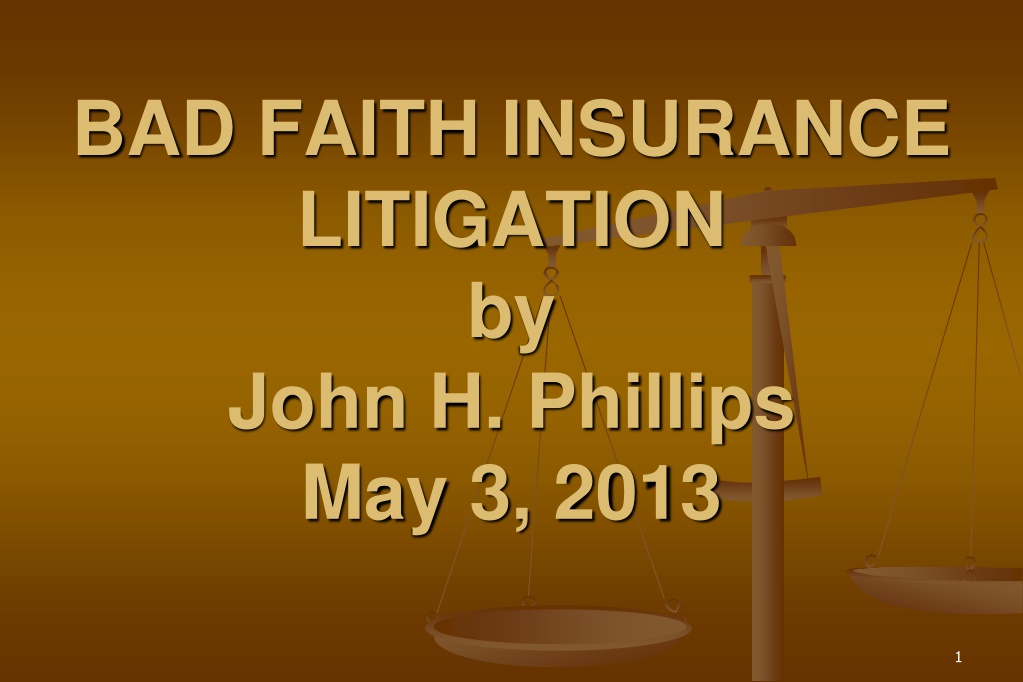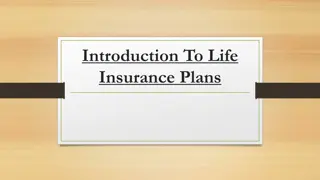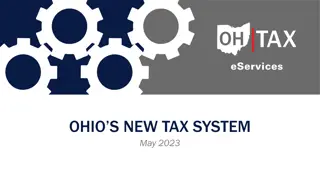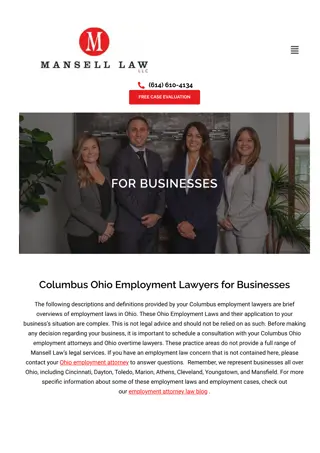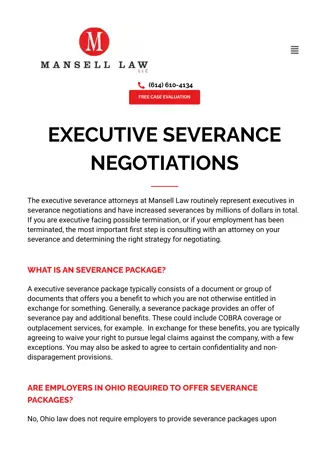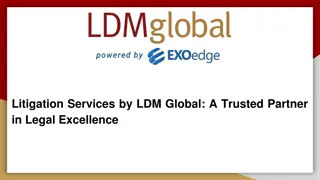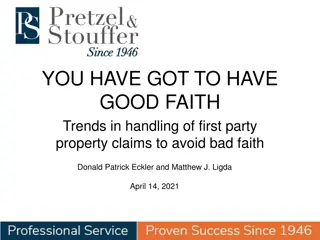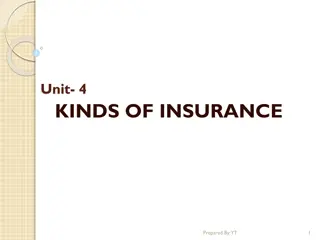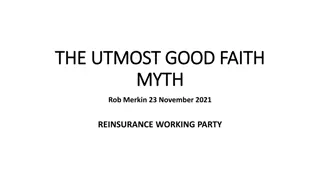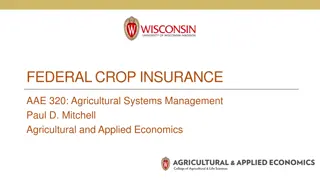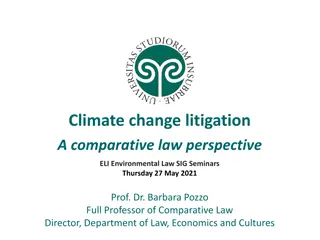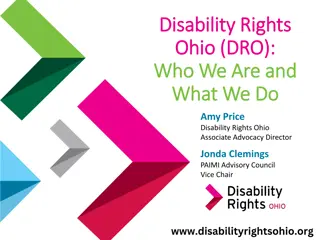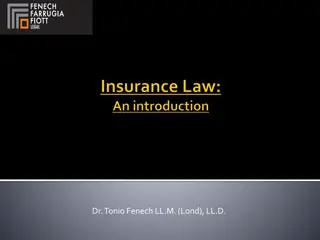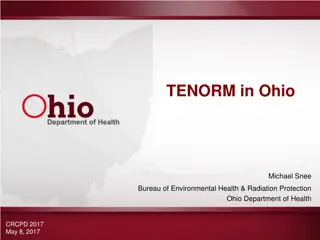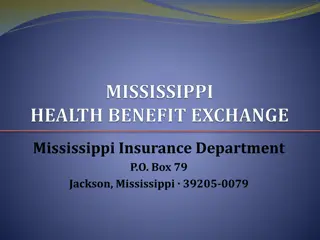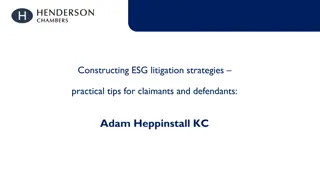Understanding Bad Faith Insurance Litigation in Ohio
Insurance bad faith is a serious issue where an insurer fails to act in good faith towards their insured. In Ohio, the Supreme Court has established the duty of good faith owed by insurers to policyholders. This duty includes the fair processing, payment, and settlement of claims. Failure to meet this duty can lead to legal action under the tort of bad faith, as outlined in relevant court cases. Additionally, the failure to disclose insurance coverage provisions can also result in legal consequences. Understanding these concepts is crucial for both insurers and insured parties in Ohio.
Download Presentation

Please find below an Image/Link to download the presentation.
The content on the website is provided AS IS for your information and personal use only. It may not be sold, licensed, or shared on other websites without obtaining consent from the author. Download presentation by click this link. If you encounter any issues during the download, it is possible that the publisher has removed the file from their server.
E N D
Presentation Transcript
BAD FAITH INSURANCE LITIGATION by John H. Phillips May 3, 2013 1
BACKGROUND Insurance bad faith is a tort claim that an insured person may have against an insurance company for its bad acts. The Ohio Supreme court has held that an insurer owes a duty of good faith to its insured in the processing, payment, satisfaction, and settlement of the insured's claims. Hart v. Republic Mut. Ins. Co. (1949), 152 Ohio St. 185, 87 N.E.2d 347. This duty is often referred to as the "implied covenant of good faith and fair dealing" which automatically exists by operation of law in every insurance contract. 2
NO LAWFUL BASIS AND FAILURE TO DETERMINE A LAWFUL BASIS In Motorists Mutual Ins. Co. v. Said (1992), 63 Ohio St.3d 690, 590 N.E.2d 1228, the Ohio Supreme Court held that a cause of action for the tort of bad faith exists: * * * when an insurer breaches its duty of good faith by intentionally refusing to satisfy an insured's claim where there is either (1) no lawful basis for the refusal coupled with actual knowledge of that fact or (2) an intentional failure to determine whether there was any lawful basis for such refusal. Intent that caused the failure may be inferred and imputed to the insurer when there is a reckless indifference to facts or proof reasonably available to it in considering the claim. 3
NO LAWFUL BASIS DEFINED No lawful basis' for the intentional refusal to satisfy a claim means that the insurer lacks a reasonable justification in law or fact for refusing to satisfy the claim. Where a claim is fairly debatable the insurer is entitled to refuse the claim as long as such refusal is premised on a genuine dispute over either the status of the law at the time of the denial or the facts giving rise to the claim. Said, supra at 699-700, 590 N.E.2d 1228. 4
FAILURE TO DISCLOSE COVERAGE OF INSURANCE OAC Ann. 3901-1-54: (E) Misrepresentation of policy provisions. (1) An insurer shall fully disclose to first party claimants all pertinent benefits, coverages or other provisions of an insurance contract under which a claim is presented. (2) No agent shall willfully conceal from first party claimants benefits, coverages or other provisions of any insurance contract when such benefits, coverages or other provisions are pertinent to a claim. 5
Sidebar on The Ohio Unfair Claims Settlement Practice Act Ohio s appellate courts have consistently found no legislative intent that would create a private cause of action under the Ohio Unfair Claims Practice Act. As such, they have determined that creating such a cause of action would be inconsistent with the underlying purpose of the Act. (Strack v. Westfield Co. (1988), 33 Ohio App.3d 336, 515 N.E.2d 1005; Furr v. State Farm Mut. Auto. Ins. Co. (1998), 128 Ohio App.3d 607, 716 N.E.2d 250). The Act is regulatory only. However, violations of the Act can be introduced as evidence of bad faith insurance handling. 6
WHY CLAIM BAD FAITH? (1 of 2) If an insurance company violates that covenant of good faith, the insured person (or "policyholder") may sue the company on a tort claim in addition to a standard breach of contract claim. The contract-tort distinction is significant because as a matter of public policy, punitive or exemplary damages are unavailable for contract claims, but are available for tort claims. 7
WHY CLAIM BAD FAITH? (2 of 2) The result is that a plaintiff in an insurance bad faith case may be able to recover an amount larger than the original face value of the policy, if the insurance company's conduct was particularly egregious. Ohio law recognizes the tort of insurer bad faith in situations in which an insurer refuses to pay a valid claim. Florists' Mut. Ins. Co. v. Ludy Greenhouse Mfg. Corp. (S.D.Ohio, 09-30-2007) 521 F.Supp.2d 661. 8
ONLY THE POLICYHOLDER HAS A BAD FAITH CLAIM. (1 of 2) A claim of bad faith cannot be brought against an insurer by a third-party claimant. Pasipanki v. Morton (1990), 61 Ohio App.3d 184, 185, 572 N.E.2d 234, citing Hoskins v. Aetna Life Ins. Co. (1983), 6 Ohio St.3d 272, 275-276, 452 N.E.2d 1315. The duty to act in good faith runs only from the insurer to its own insured. Pasipanki, at 185, 572 N.E.2d 234. 9
ONLY THE POLICYHOLDER HAS A BAD FAITH CLAIM. (2 of 2) Although an insurer owes a duty to its insured to negotiate in good faith with a party injured by the insured, there is no such independent duty to the injured party, nor is he a third party beneficiary to the insurance contract. Achor v. Clinton Cty. Bd. of Mental Retardation & Developmental Disabilities (June 5, 1986), Franklin App. No. 86AP-60. 10
THE INSURANCE COMPANY SAID NO. IS IT BAD FAITH? THERE ARE TWO TYPES OF BAD FAITH INSURANCE CLAIMS. FAILURE TO PAY Failure to pay a covered loss means that you are the policy holder, and you have suffered a loss covered by the policy of insurance. You make a claim and the insurance company refuses to pay the claims without justification. FAILURE TO PROTECT Failure to protect means that someone has made a claim against you, and the insurance company refuses to protect you against the claim within the policy limits, and an excess judgment is taken against the policy holder. 11
FAILURE TO PAY EXAMPLE HOUSE FIRE AND PROPERTY DAMAGE ONLY CLAIM Facts: Your house catches fire due to your negligence in leaving a candle burning. You file a proof of claim with your homeowner s insurance company, and the insurance company says that you may not collect because the fire is suspicious. Question: Is it bad faith? Answer: Maybe, but not necessarily. 12
ARSON DEFENSE In defending against an action to recover on a fire insurance policy, the insurer may raise the defense of arson as an affirmative defense; to establish such a defense, the insurer must prove, by a preponderance of the evidence (either circumstantial or direct), that three basic elements exist: (1) the fire was of an incendiary nature; (2) the insured had a motive to commit arson; and (3) the insured had the opportunity to cause the fire to be set. Caserta v. Allstate Ins. Co. (Franklin 1983) 14 Ohio App.3d 167, 470 N.E.2d 430, 14 O.B.R. 185. 13
YOUR DUTY TO COOPERATE If insured's failure to cooperate prejudices rights of insurer and is material and substantial, insured's lack of cooperation constitutes defense to liability. Templin v. Grange Mut. Cas. Co. (Montgomery 1992) 81 Ohio App.3d 572, 611 N.E.2d 944. Insured's refusal to produce requested records for insurer, including financial records, income tax returns, rental property records, bank statements, credit card account statements, and cellular phone records, in relation to insured's fire loss claim was a breach of duty to cooperate with insurer and materially prejudiced insurer's investigation, precluding insured's claims for breach of contract and bad faith. Doerr v. Allstate Ins. Co. (C.A.6 (Ohio), 02-03-2005) No. 03-4529, 121 Fed.Appx. 638, 2005 WL 271702, Unreported. 14
Examination Under Oath The relevant insurance contract provisions required both plaintiffs to submit to examinations under oath and to provide documents. Because plaintiffs failed to do so, the court concludes that AFIC had no contractual obligation to provide the plaintiffs with insurance coverage . . . Savage v. Am. Family Ins. Co., 2008-Ohio-4460, 178 Ohio App. 3d 154, 162, 897 N.E.2d 195, 201 (2008) Produce whatever records are requested before the EUO, and produce whatever records are requested as a result of the EUO. Some attorneys make these very confrontational. 15
Polygraph Evidence (1 of 3) Does the client have to submit to a polygraph? Check your policy. I have never heard of a mandatory obligation to submit to a polygraph, but your client may voluntarily submit if he so chooses. But beware . . . Damned if you do Damned if you don t 16
POLYGRAPH EVIDENCE (2 of 3) Damned if you do Failing a polygraph is a basis for rejection of coverage. Where an insured claims that his insurer has rejected fire insurance coverage in bad faith and without basis, the insurer may present the results of a polygraph examination of the insured to show that the insured had answered questions deceptively, not as proof of arson, but to counter the insured's claim of bad faith and to establish a basis for rejection of coverage. Moss v. Nationwide Mut. Ins. Co. (Franklin 1985) 24 Ohio App.3d 145, 493 N.E.2d 969, 24 O.B.R. 234 17
Polygraph Evidence (3 of 3) Damned if you don t. Admissible if you refuse as evidence of insured credibility and Insurer s motive in refusing the claim. Murphy v. Cincinnati Ins. Co., 772 F.2d 273 (1985), at 277, stated: Since [the insured's] willingness to submit to a polygraph examination reflected upon his credibility and the defendant's motive in refusing the claim, the district court did not err in concluding that the evidence is relevant. 18
Third Party Beneficiaries Mortgage Holders are almost always listed as an additional insured on your homeowners insurance policy. Mortgage companies are not always the best at filing proofs of loss. Questions: Does the insurance company have an obligation to pay off the Mortgage Holder as a Third Party Beneficiary? Answer: No! Not without a proof of loss. 19
YOUR MORTGAGE COMPANY AS AN ADDITIONAL INSURED Homeowners' insurer's delay in paying mortgage holder . . . did not establish bad faith handling of fire loss claim, where mortgage holder was entitled to be paid only upon submission of proof of loss, insurer requested proof of loss, and mortgage holder never responded to insurer's request. Farmers Ins. of Columbus, Inc. v. Lister (Ohio App. 5 Dist., Fairfield, 01-09-2006) No. 2005-CA-29, 2006-Ohio-142, 2006 WL 92946, Unreported, appeal not allowed 109 Ohio St.3d 1481, 847 N.E.2d 1226, 2006-Ohio-2466. Consider a suit against the mortgage holder. 20
STATUTE OF LIMITATIONS BREACH OF CONTRACT EVERY LAWYER KNOWS A BREACH OF WRITTEN CONTRACT IS A 15 YEAR STATUTE OF LIMITATIONS, RIGHT? NO!!! R.C. 2305.06 - Except as provided in sections 126.301 and 1302.98 of the Revised Code, an action upon a specialty or an agreement, contract, or promise in writing shall be brought within fifteen eight years after the cause thereof of action accrued. 2012 S 224, eff. 9-28-12 21
STATUTE OF LIMITATIONS BAD FAITH An action by an insured against an insurer, alleging bad faith on the part of the insurer in adjusting damage claims, is essentially a tort action governed by the four-year statute of limitations set forth in RC 2305.09, rather than a contractual limitation period contained in the insurance policy. United Dept. Stores Co. No. 1 v. Continental Cas. Co. (Hamilton 1987) 41 Ohio App.3d 72, 534 N.E.2d 878. 22
MALPRACTICE ALERT CHECK YOUR POLICY!!!! An insurance contract may lawfully limit the time within which a suit may be brought on that contract of insurance if the period fixed in the policy is not unreasonable. Appel v. Cooper Ins. Co. (1907), 76 Ohio St. 52, 80 N.E. 955. Such provisions are valid even though the limitation period provided in the contract of insurance is shorter than the period specified in the applicable statute, and a limitation on periods for the commencement of actions to a period of 12 months is not unreasonable. Appel, supra. 23
A Personal Injury example Facts: Your client was riding his motorcycle when he was hit by an automobile. Your client suffered multiple broken bones and a skull fracture. He has significant medical bills. Liability is not disputed. The driver of the automobile has $12,500 in insurance coverage and no other assets. Your client has coverage for Uninsured Motorist Coverage (UIM) claims of $25,000 with Allstate Insurance. 24
A simple case - right? Demand policy limits from the tortfeasor. They Agree to pay. MALPRACTICE ALERT Do not accept policy limits from the tortfeasor until the UIM carrier gives you permission to accept after an asset search. Accepting without the permission of the UIM Carrier could void the UIM coverage. 25
Your letter to Allstate, your client s UIM Carrier. Advise the UIM carrier of the accident Give a brief summary of the facts Ask the UIM carrier to perform an asset check of the tortfeasor Advise that if there are inadequate assets found, ask for permission to settle with the tortfeasor, or demand that Allstate advance the tortfeasor s policy limits ($12,500). Advise that you are making a claim under the UIM policy for policy limits. 26
Allstates response We are in receipt of your letter stating that you represent John Doe, our insured in this accident. The policy was thoroughly reviewed and he doesn t have Underinsured Motorist Coverage. Please contact me at the number listed below if you have any further questions. REALLY? 27
Your Response Acknowledge receipt of their letter Attach a copy of the declarations page Request a complete copy of the policy I go through the agent for this. Much faster. Ask for an explanation of why the UIM is being denied since it is listed on the declarations page. Ask them to Please respond ASAP. 28
Allstates Response Please be advised that I am in receipt of your letter. The policy information that was included with the letter was reviewed with the coverages he has on his policy for the motorcycle. There is Uninsured Motorist Bodily Injury coverage. That is if the other party had no insurance. There is no Underinsured Motorist Bodily Injury coverage on this file. This coverage is needed if the liable party has lower limits than our policy for the medical expenses. Please let me know if you have any further questions. 29
Your Response (1 of 5) State the steps you have taken to recover the UIM policy coverage, and be specific. Allstate s representative and I confirmed that Policy Form Number AU10777 was the applicable policy, and together we read from Page 14, Part 3, as follows: An Uninsured Motor Vehicle Is: . . . 5. an underinsured motor vehicle which has liability protection . . . less than the limits of liability for Uninsured Motorist Insurance shown on the Policy Declarations. 30
Your Response (2 of 5) Ask for any applicable endorsements affecting coverage: I asked Allstate to send to me via email or facsimile any endorsements in place, or waivers that my client may have signed, that would have changed the above part of the applicable policy. To date, I have received nothing. However, my office received a telephone call on February 24, 2011, from Allstate again confirming that Allstate would not provide Underinsured Motorist Coverage, because although your insured and my client had Uninsured Motor Vehicle Coverage, Allstate s position is that he does not have Underinsured Motorist Coverage, despite the above language from the policy. 31
Your Response (3 of 5) Remind them of the law: Allstate s actions are specifically prohibited by the Ohio Department of Insurance, which states in pertinent part from OAC Ann. 3901-1-54: (E) Misrepresentation of policy provisions. (1) An insurer shall fully disclose to first party claimants all pertinent benefits, coverages or other provisions of an insurance contract under which a claim is presented. (2) No agent shall willfully conceal from first party claimants benefits, coverages or other provisions of any insurance contract when such benefits, coverages or other provisions are pertinent to a claim. 32
Your Response (4of 5) Advise them of the bad faith claim: Allstate has breached its contract with its insured, and as a result of the breach, compensatory damages recoverable from Allstate are not limited by the original policy limit. Furthermore, because your actions are in bad faith, my client demands exemplary damages over and above his compensatory damages suffered. I am asking that you immediately forward this letter and your entire file to your bad faith claims unit to engage the undersigned in negotiations on the damages recoverable as a result of Allstate s actions. 33
Your Response (5 of 5) Evidence Preservation I am demanding that you enter into an evidence preservation agreement, and I am requesting that all electronically stored information be preserved for purposes of litigation in this matter. Since Allstate warns all callers that their calls will be recorded, this demand includes electronically recorded telephone conversations. Failure to preserve and to produce any evidence in your possession will be grounds for a spoliation of evidence claim against Allstate also. 34
Allstates Response I am pleased that we have been able to settle this claim in an amicable manner. You will find enclosed the release agreement for your client s signature. Please return a signed original of the enclosed release to my attention. With the release was a check for $12,500. The Release stated that the insured, releases Allstate from any and all liability and from any and all contractual obligations Insisting on a release of all liability and not just contractual liability is bad faith. 35
THE COMPLAINT 1. Declaratory Judgment Declare the Policy of Insurance to be valid. 2. Breach of Contract Declare that the Insurance Company breached the contract. 3. Bad Faith Declare that the Insurance Company s Breach was in Bad Faith. 4. Punitive Damages Punish them so that the insurance company does not do this again. 5. Attorney Fees Award attorney fees for having to bring the Insurance Company to Justice. 36
YOU MUST REQUEST ATTORNEY FEES IN THE COMPLAINT Despite a finding that a defendant acted in bad faith, a trial court is without jurisdiction to award attorney fees to a plaintiff where the plaintiff has failed to petition the court for fees in its declaratory judgment action as required under RC 2721.09. Wagner v. Cleveland (Cuyahoga 1988) 62 Ohio App.3d 8, 574 N.E.2d 533. (Decided under the Declaratory Judgment Statute R.C. 2721.09) 37
EXPECT A BIFURCATION OF CLAIMS FOR BAD FAITH R.C. 2315.21(B) creates, defines, and regulates a substantive, enforceable right to separate stages of trial relating to the presentation of evidence for compensatory and punitive damages in tort actions and therefore takes precedence over Civ.R. 42(B). Civ.R. 42(B) is discretionary with the court, and R.C. 2315.21(B) is mandatory. Havel v. Villa St. Joseph, 2012-Ohio-552, 131 Ohio St. 3d 235, 245, 963 N.E.2d 1270, 1279 (2012). 38
DO I NEED AN EXPERT WITNESS? No, but you may use an expert witness. Testimony explaining basic principles of insurance law and practice and opining that the insured's claim for uninsured motorist (UM) benefits was handled improperly was admissible under the expert testimony rule in the insured's bad faith suit; the testimony either related to matters beyond the knowledge or experience possessed by lay persons or dispels a misconception common among lay persons. Furr v. State Farm Mut. Auto. Ins. Co. (Ohio App. 6 Dist., 06-26-1998) 128 Ohio App.3d 607, 716 N.E.2d 250. 39
DISCOVERY (1 OF 2) Immediately ask for the claims file Immediately ask for the personnel file of all persons handling the claim. Immediately ask for the claims handling procedures manual. Immediately ask for the recordings of the telephone conversations. Request the McKinsey Documents (the fact that you even know what McKinsey documents are will get their attention). 40
DISCOVERY (2 OF 2) In an action alleging bad faith denial of insurance coverage, the insured is entitled to discover claims file materials containing attorney-client communications that are related to the issue of coverage and were created prior to the denial of coverage. Boone v. Vanliner Ins. Co. (Ohio, 04-04- 2001) 91 Ohio St.3d 209, 744 N.E.2d 154, 2001- Ohio-27, reconsideration denied 91 Ohio St.3d 1530, 747 N.E.2d 254, certiorari denied 122 S.Ct. 506, 534 U.S. 1014, 151 L.Ed.2d 415. 41
What if you are not the policy holder, and the opposing party s insurance company will not settle? Assuming damages in excess of the policy limits, if the opposing party has inadequate assets to pay the damages, send a letter indicating that opposing counsel is to inform his or her client that you are willing to enter into a consent judgment if the insurance company refuses to pay the policy limits. Demand that his client put the insurance company on notice of the desire to settle for the policy limits. If the insurance company refuses, ask for an assignment of the bad faith claim. 42
The assignment of a bad faith claim. (1 of 4) In the instance of an insurance coverage dispute, the assignment given by the insured to the claimant typically contains three components. The first is a judgment establishing the insured s liability.This judgment can be obtained through various procedures, that may be important in determining the weight a subsequent court will give to the judgment. 43
The assignment of a bad faith claim. (2 of 4) The second element is a covenant not to execute given by the claimant to the insured, guaranteeing that the claimant will not attempt to enforce the judgment on any of the insured s assets, with the exception of the insurance policy. 44
The assignment of a bad faith claim. (3 of 4) Finally, the insured assigns to the claimant, any rights it may have under the insurance policy or against the insurer.Armed with this assignment of rights, the claimant then brings suit against the insurer as assignee of the insured for payment on the policy and additional bad faith damages. 45
The Assignment of a bad faith claim. (4 of 4) The tortfeasor need not assign 100% of his bad faith claim. In Johnson, et al. v. Allstate, Case No. WD68169, Circuit Court of Jackson County Missouri, Wayne Davis assigned only 90% of his bad faith claim against Allstate to the Johnsons for his drunken auto accident that severely injured the Johnsons when Allstate refused to settle for the policy limits of $50,000. The trial court awarded $10.5 million in damages as to the bad faith claim, making the tortfeasor a millionaire. 46
Buy this trial guide if you are the Plaintiff Against Allstate From Good Hands to Boxing Gloves How Allstate Changed Casualty Insurance in America - The Definitive Guide to Handling Allstate Claims David J. Berardinelli Michael D. Freeman Aaron C. DeShaw Foreword by Eugene R. Anderson Published by Trial Guides, LLC *You must sign an affidavit that you are not a defense attorney if you buy the book. 47
